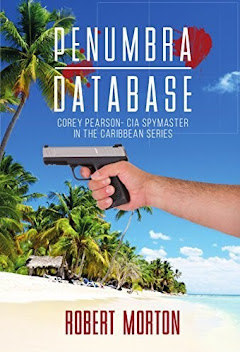 |
| When CIA operatives and SAC commandos converge, it’s silent strikes, zero mercy, and no proof they were ever there |
You’ve
probably never heard of them—and that’s the point. When diplomatic options
collapse and sending in the military would spark an international crisis, the
CIA turns to the quiet professionals who don’t exist on paper: their field
operatives and the lethal paramilitary commandos of the Special Activities
Center, known as SAC.
These aren’t ordinary soldiers or agents.
Ground Branch operators—often drawn from elite units like SEAL Team 6, Delta
Force, and Marine Raiders—are trained for one thing: to go where the U.S.
government won’t admit it goes and do what it won’t admit it did. They blend
in, disappear, and leave no trace except a stopped threat and a clean exit.
In my spy thriller Crimson
Shadows, CIA spymaster Corey Pearson finds
himself in the thick of a covert operation that echoes real-world CIA missions.
When rogue Panamanian General Hector Alvarez plots a coup to overthrow his
country’s fragile democracy—with backing from Russian oligarch Viktor Orlov and
a brutal cartel—Corey is tasked with dismantling a threat that could
destabilize the Western Hemisphere.
The mission is deniable, the stakes are
global, and the enemy isn’t just Alvarez—it’s the Kremlin’s playbook unfolding
in America’s backyard. Corey and his elite CIA team link up with SAC commandos
to move silently through cartel-held jungle terrain, staging recon under the
guise of bird researchers and preparing for a daring nighttime raid on a
fortified plantation. There’s no room for error. Every move is calculated,
every firefight personal.
This fusion of elite intelligence and
special operations reflects the real dynamics between CIA operatives and SAC
teams. One of the clearest examples came just weeks after 9/11, when CIA and
SAC were the first Americans to enter Afghanistan. Before the U.S. military
deployed in force, a small, covert CIA team from the agency’s Special
Activities Division (now SAC) landed deep behind enemy lines. They linked up
with the Northern Alliance, carried duffel bags stuffed with millions in cash,
and began coordinating resistance against the Taliban.
These few CIA paramilitary officers,
riding horseback through mountainous terrain with Afghan warlords, directed
airstrikes and relayed real-time intel to Langley. They didn’t just pave the
way for the war—they shaped it. Without them, the Northern Alliance would never
have pushed back so quickly. That mission set the tone for the post-9/11
intelligence battlefield: small, smart, and surgical.
Then came Benghazi. On September 11, 2012,
when a U.S. diplomatic compound in Libya came under attack, there was no
military rescue team standing by. Instead, it was a CIA team—comprised of field
operatives and SAC paramilitary officers—who sprang into action. Tyrone “Rone”
Woods and Glen “Bub” Doherty, both former Navy SEALs now working under SAC,
heard the gunfire, defied orders to stand down, and headed toward the flames.
They navigated a city in chaos, pulled survivors from the smoke, and returned
fire against waves of attackers for hours.
When militants turned their mortars on the
annex, Rone and Bub held their ground, covering others with their lives. No
headlines, no hero’s welcome—just quiet, relentless courage. Their sacrifice
reminded the world that when the cavalry can’t come, SAC shows up.
That same spirit drives Crimson Shadows. Corey
Pearson’s mission to stop General Alvarez isn’t just about boots-on-the-ground
action—it’s about precision and restraint, knowing one wrong step could ignite
a war. When Corey confronts cartel forces training on a plantation funded by the
corrupt Russian oligarch Orlov’s millions, he has to call in the SAC team for a
synchronized strike.
The plan unfolds in silence and
speed—helicopter insertions under cover of night, explosive entries on cartel
safehouses, Russian advisors taken down before they ever see it coming. Corey
calls the shots, but SAC executes with ruthless efficiency. The team leaves
scorched earth behind—but more importantly, they leave no fingerprints.
Operations like these are why SAC doesn’t
wear uniforms. They wear legends. They operate in the gray zone between
diplomacy and war, where things get messy and the mission isn’t always morally
clean. They're the embodiment of the CIA’s Third Option—covert action with no
press, no parades, and no screwups. The men and women of SAC don’t just breach
doors. They change the course of events before most people even realize
something was at stake.
What makes Crimson Shadows more
than fiction is how closely it mirrors today’s geopolitical reality. A rogue
general in Latin America propped up by a rich Russian oligarch’s wealth and
cartel brutality isn’t far-fetched—it’s plausible, even probable. The
combination of Russian oligarchs funding destabilization and violent non-state
actors executing it is happening in multiple corners of the world. Corey’s
mission isn’t just about bullets and betrayal—it’s about sending a message:
foreign influence in America’s backyard comes at a price. Taking down Alvarez
means dismantling Orlov’s grip and reminding Moscow that the CIA hasn’t
forgotten how to play its own game.
Whether it’s real-world heroes like Woods
and Doherty or fictional operatives like Corey Pearson, one truth remains:
you’ll never know their names—but you’re safer because of them. The CIA’s
covert warriors operate in silence, but their impact echoes loudly across the
globe.
Robert Morton is a member of the Association of Former Intelligence Officers (AFIO) and an accomplished author. He writes the Corey Pearson- CIA Spymaster Short Story series, blending his knowledge of real-life intelligence operations with gripping fictional storytelling. His work offers readers an insider’s glimpse into the world of espionage, inspired by the complexities and high-stakes realities of the intelligence community.





No comments:
Post a Comment